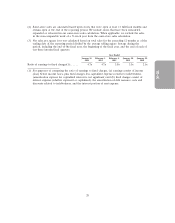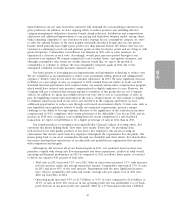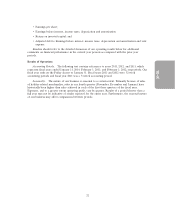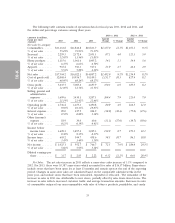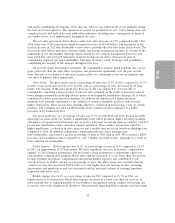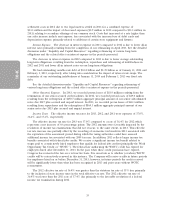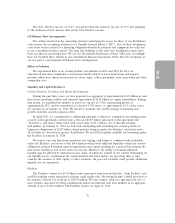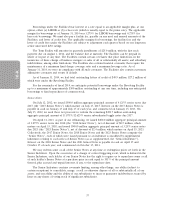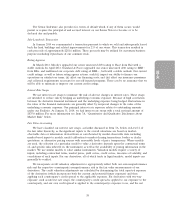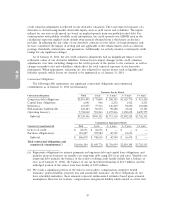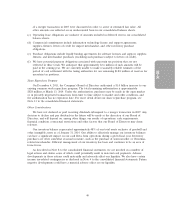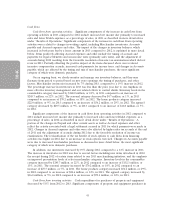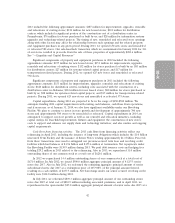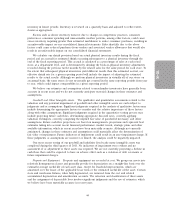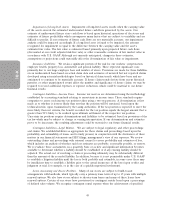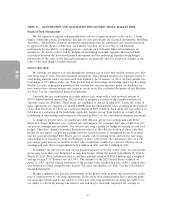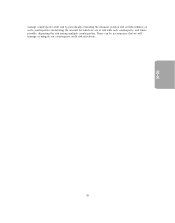Dollar General 2013 Annual Report Download - page 115
Download and view the complete annual report
Please find page 115 of the 2013 Dollar General annual report below. You can navigate through the pages in the report by either clicking on the pages listed below, or by using the keyword search tool below to find specific information within the annual report.
The Senior Indenture also provides for events of default which, if any of them occurs, would
permit or require the principal of and accrued interest on our Senior Notes to become or to be
declared due and payable.
Sale-Leaseback Transaction
In January 2014 we consummated a transaction pursuant to which we sold and subsequently leased
back the land, buildings and related improvements for 233 of our stores. This transaction resulted in
cash proceeds of approximately $281.6 million. These proceeds may be utilized for customary business
purposes including repurchases of our common stock.
Rating Agencies
In March 2013, Moody’s upgraded our senior unsecured debt rating to Baa3 from Ba2 with a
stable outlook. In April 2013, Standard & Poor’s upgraded our senior unsecured debt rating to BBBǁ
from BB+ and reaffirmed our corporate debt rating of BBBǁ, both with a stable outlook. Our current
credit ratings, as well as future rating agency actions, could (i) impact our ability to finance our
operations on satisfactory terms; (ii) affect our financing costs; and (iii) affect our insurance premiums
and collateral requirements necessary for our self-insured programs. There can be no assurance that we
will be able to maintain or improve our current credit ratings.
Interest Rate Swaps
We use interest rate swaps to minimize the risk of adverse changes in interest rates. These swaps
are intended to reduce risk by hedging an underlying economic exposure. Because of high correlation
between the derivative financial instrument and the underlying exposure being hedged, fluctuations in
the value of the financial instruments are generally offset by reciprocal changes in the value of the
underlying economic exposure. Our principal interest rate exposure relates to outstanding amounts
under our Facilities. At January 31, 2014, we had interest rate swaps with a total notional amount of
$875.0 million. For more information see Item 7A, ‘‘Quantitative and Qualitative Disclosures about
Market Risk’’ below.
Fair Value Accounting
We have classified our interest rate swaps, as further discussed in Item 7A. below, in Level 2 of
the fair value hierarchy, as the significant inputs to the overall valuations are based on market-
observable data or information derived from or corroborated by market-observable data, including
market-based inputs to models, model calibration to market-clearing transactions, broker or dealer
quotations, or alternative pricing sources with reasonable levels of price transparency. Where models
are used, the selection of a particular model to value a derivative depends upon the contractual terms
of, and specific risks inherent in, the instrument as well as the availability of pricing information in the
market. We use similar models to value similar instruments. Valuation models require a variety of
inputs, including contractual terms, market prices, yield curves, credit curves, measures of volatility, and
correlations of such inputs. For our derivatives, all of which trade in liquid markets, model inputs can
generally be verified.
We incorporate credit valuation adjustments to appropriately reflect both our own nonperformance
risk and the respective counterparty’s nonperformance risk in the fair value measurements of our
derivatives. The credit valuation adjustments are calculated by determining the total expected exposure
of the derivatives (which incorporates both the current and potential future exposure) and then
applying each counterparty’s credit spread to the applicable exposure. For derivatives with two-way
exposure, such as interest rate swaps, the counterparty’s credit spread is applied to our exposure to the
counterparty, and our own credit spread is applied to the counterparty’s exposure to us, and the net
38
10-K


